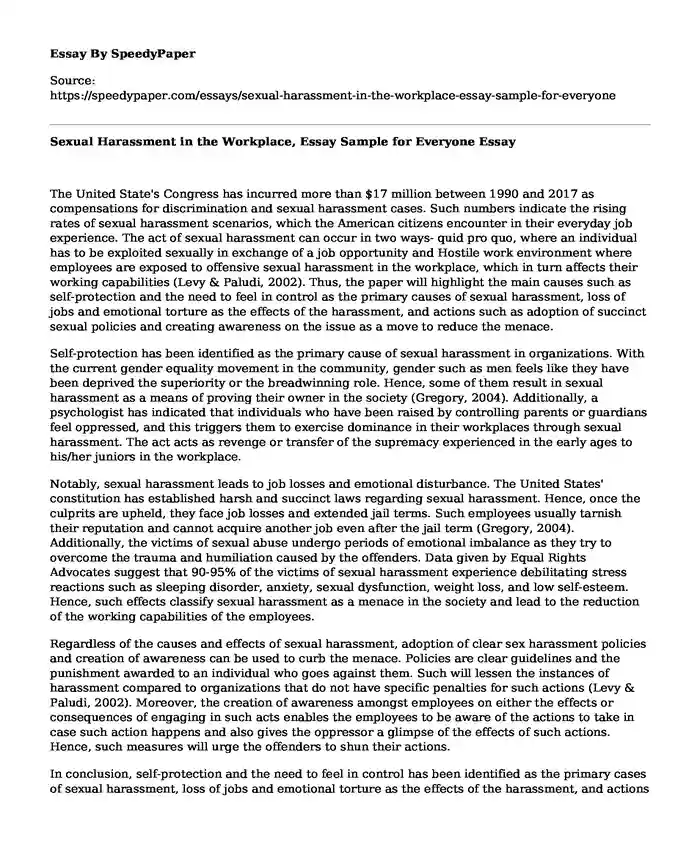
| Type of paper: | Presentation |
| Categories: | Sexual abuse |
| Pages: | 3 |
| Wordcount: | 641 words |
The United State's Congress has incurred more than $17 million between 1990 and 2017 as compensations for discrimination and sexual harassment cases. Such numbers indicate the rising rates of sexual harassment scenarios, which the American citizens encounter in their everyday job experience. The act of sexual harassment can occur in two ways- quid pro quo, where an individual has to be exploited sexually in exchange of a job opportunity and Hostile work environment where employees are exposed to offensive sexual harassment in the workplace, which in turn affects their working capabilities (Levy & Paludi, 2002). Thus, the paper will highlight the main causes such as self-protection and the need to feel in control as the primary causes of sexual harassment, loss of jobs and emotional torture as the effects of the harassment, and actions such as adoption of succinct sexual policies and creating awareness on the issue as a move to reduce the menace.
Self-protection has been identified as the primary cause of sexual harassment in organizations. With the current gender equality movement in the community, gender such as men feels like they have been deprived the superiority or the breadwinning role. Hence, some of them result in sexual harassment as a means of proving their owner in the society (Gregory, 2004). Additionally, a psychologist has indicated that individuals who have been raised by controlling parents or guardians feel oppressed, and this triggers them to exercise dominance in their workplaces through sexual harassment. The act acts as revenge or transfer of the supremacy experienced in the early ages to his/her juniors in the workplace.
Notably, sexual harassment leads to job losses and emotional disturbance. The United States' constitution has established harsh and succinct laws regarding sexual harassment. Hence, once the culprits are upheld, they face job losses and extended jail terms. Such employees usually tarnish their reputation and cannot acquire another job even after the jail term (Gregory, 2004). Additionally, the victims of sexual abuse undergo periods of emotional imbalance as they try to overcome the trauma and humiliation caused by the offenders. Data given by Equal Rights Advocates suggest that 90-95% of the victims of sexual harassment experience debilitating stress reactions such as sleeping disorder, anxiety, sexual dysfunction, weight loss, and low self-esteem. Hence, such effects classify sexual harassment as a menace in the society and lead to the reduction of the working capabilities of the employees.
Regardless of the causes and effects of sexual harassment, adoption of clear sex harassment policies and creation of awareness can be used to curb the menace. Policies are clear guidelines and the punishment awarded to an individual who goes against them. Such will lessen the instances of harassment compared to organizations that do not have specific penalties for such actions (Levy & Paludi, 2002). Moreover, the creation of awareness amongst employees on either the effects or consequences of engaging in such acts enables the employees to be aware of the actions to take in case such action happens and also gives the oppressor a glimpse of the effects of such actions. Hence, such measures will urge the offenders to shun their actions.
In conclusion, self-protection and the need to feel in control has been identified as the primary cases of sexual harassment, loss of jobs and emotional torture as the effects of the harassment, and actions such as adoption of succinct sexual policies and creating awareness on the issue as a move to reduce the menace. Hence, with the identified causes and effects, organizations ought to advocate for the creation of a conducive environment to all genders and ensure that those caught in action are prosecuted.
References
Equal Rights Advocates. (2018). Fighting for Women's Equality. Retrieved 10 April 2018, from https://www.equalrights.org/sexhar/work/workfact.htm.
Gregory, R. (2004). Unwelcome and unlawful. Ithaca: Cornell University Press.
Levy, A., & Paludi, M. (2002). Workplace sexual harassment. Upper Saddle River, NJ: Prentice Hall.
Cite this page
Sexual Harassment in the Workplace, Essay Sample for Everyone. (2022, May 06). Retrieved from https://speedypaper.com/essays/sexual-harassment-in-the-workplace-essay-sample-for-everyone
Request Removal
If you are the original author of this essay and no longer wish to have it published on the SpeedyPaper website, please click below to request its removal:
- Literary Essay Sample: Use of Metaphors in Emily Dickinson's Poem
- Free Essay on Sexual Harassment at the Work Place
- Reduction of Potential Waste - Free Essay in Waste Management
- United Nations Security Council, Free Essay Example
- Free Essay: PR in Apple's iPhone 5s Advertisement
- Interview with Marguerite Loucas, Business Essay Example
- Paper Example on Airline and Airport Management
Popular categories




